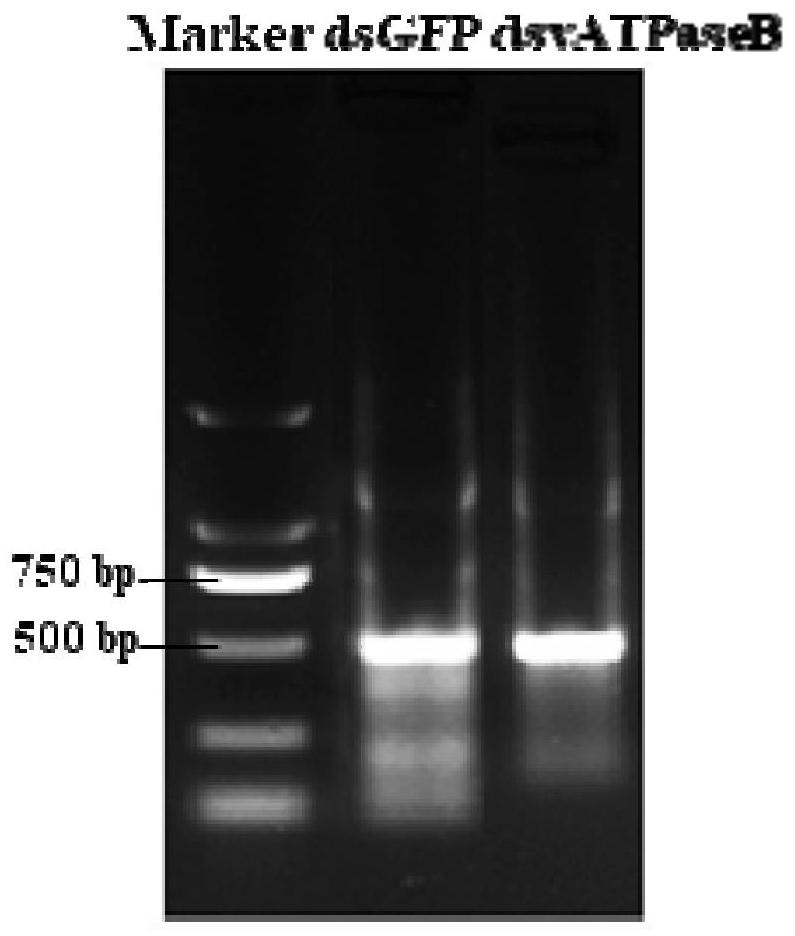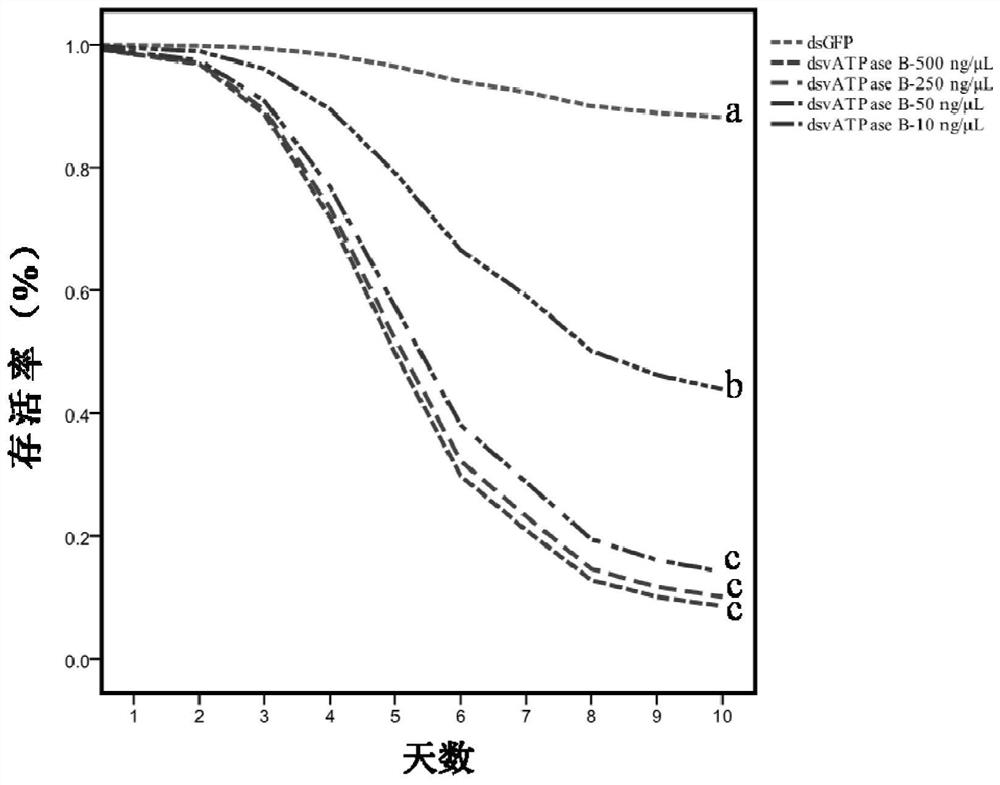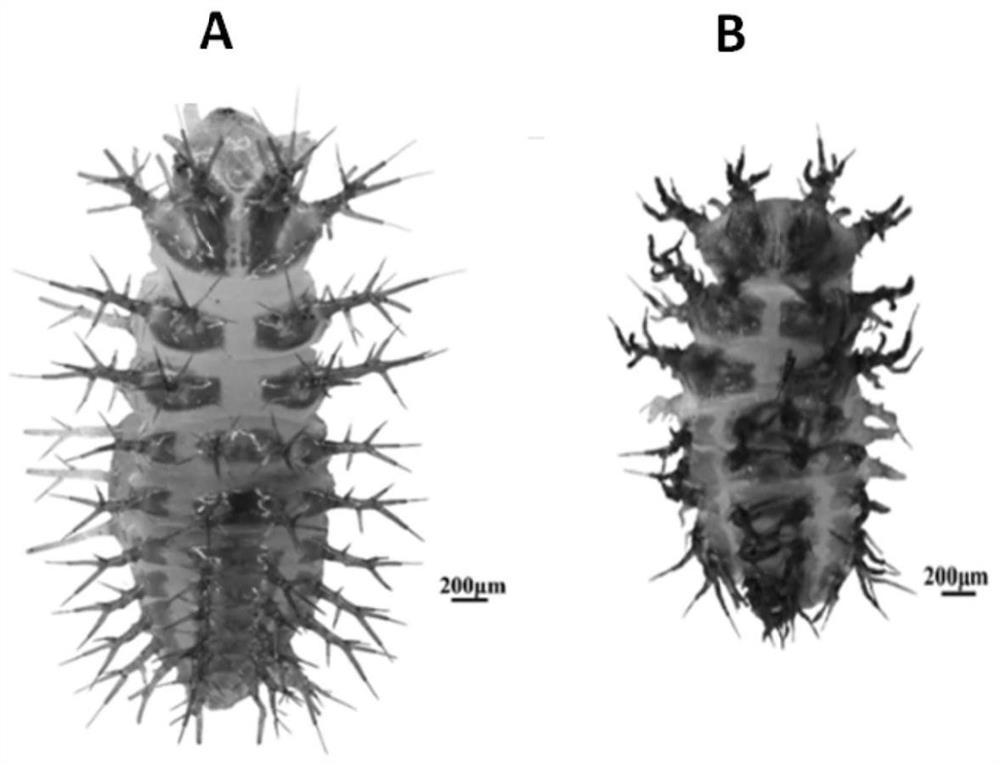High lethal gene vatpase B and its application against ladybugs
A gene and target gene technology, applied in the application field of highly lethal gene vATPaseB and its anti-ladybug, can solve the problems of no insecticidal activity, no research on the function of the ladybug gene, and achieve effectiveness and sensitivity Good performance, convenient operation, and good application prospects
- Summary
- Abstract
- Description
- Claims
- Application Information
AI Technical Summary
Problems solved by technology
Method used
Image
Examples
Embodiment 1
[0032] Example 1 The acquisition of gene vATPase B kit synthetic dsRNA
[0033] We constructed its transcriptome library based on the genome of the ladybug Solanum solani, and then based on the constructed transcriptome library, researched and screened the genes related to the growth and development of the ladybug Solanum, and screened the vATPase B gene fragment, such as SEQID NO .1 shown. The dsRNA is then synthesized.
[0034] 1. Extraction of total RNA and synthesis of first-strand cDNA from ladybug Solanum solani.
[0035] Get 10 2nd instar larvae of Ladybug solani and place in 2ml centrifuge tube, utilize TRIzol method to extract the total RNA of Ladybug solani, utilize reverse transcription kit (PrimeScript TM RT reagent Kit with gDNA Eraser, TAKARA) followed the steps in the instructions for reverse transcription to synthesize the first strand of cDNA.
[0036] 2. Primer design
[0037] The gene sequence of vATPase B was obtained from the transcriptome library of La...
Embodiment 2
[0049] Example 2 Obtaining of Gene vATPase B Bacterial Liquid Expression dsRNA
[0050] 1. Construction of dsvATPase B and L4440 expression vectors
[0051] Two restriction sites were selected on the sequence of L4440, namely BamHI (GGATCC) and SacI (GAGCTC). According to the sequence information of L4440 (this sequence information has been published), the primer P1 of dsvATPase B and the primer P2 of dsGFP were respectively added with two homologous arms related to the restriction site, and the dsvATPase B construction expression vector was designed. Primer P3, and primer P4 related to constructing expression vector of dsGFP (Table 1). With the cDNA in Example 2 as a template, the reaction system and amplification program of PCR amplification are as shown in Example 2, and the dsvATPase B and dsGFP target fragments of the construction vector are obtained, and the DNA purification recovery kit (Universal DNA Purification Kit, TIANGEN) recovered the two PCR products obtained ...
Embodiment 3
[0054] Example 3 Application of dsRNA in Inhibiting the Growth and Development of Ladybug Solanum
[0055] 1. Preparation of host plants and artificial incubators for ladybird solanum
[0056] The eggplant variety fed with eggplant twenty-eight star ladybird is Wansheng Marshal round eggplant seedlings, and the artificial incubator is a 90mm petri dish with filter paper and humidified cotton balls.
[0057] 2. The application of dsvATPase B synthesized by the kit in inhibiting the growth and development of the ladybug Solanum solani
[0058] Feeding group of lady beetle dsvATPase B: 10 1st instar larvae of lady beetle solani were placed in a petri dish with filter paper and humidified cotton balls. Soak circular eggplant leaf disks with a diameter of 12 mm in the dsvATPase B solutions synthesized by the kit at concentrations of 50 ng / μL, 100 ng / μL, 250 ng / μL, and 500 ng / μL for 1 min, air-dry for 1 h, and then feed the larvae, and replace the leaves every 24 h. After two days...
PUM
 Login to View More
Login to View More Abstract
Description
Claims
Application Information
 Login to View More
Login to View More - R&D
- Intellectual Property
- Life Sciences
- Materials
- Tech Scout
- Unparalleled Data Quality
- Higher Quality Content
- 60% Fewer Hallucinations
Browse by: Latest US Patents, China's latest patents, Technical Efficacy Thesaurus, Application Domain, Technology Topic, Popular Technical Reports.
© 2025 PatSnap. All rights reserved.Legal|Privacy policy|Modern Slavery Act Transparency Statement|Sitemap|About US| Contact US: help@patsnap.com



